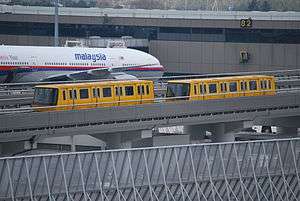Narita Airport Terminal 2 Shuttle System
The Narita Airport Terminal 2 Shuttle System (成田空港第2ターミナルシャトルシステム, Narita Kūkō Dai-ni Tāminaru Shatoru Shisutemu) was an automated people mover used in Narita International Airport, Narita, Chiba Japan. The system operated between December 6, 1992 and 2013.
 The Narita Airport Terminal 2 Shuttle System in March 2008 with a Malaysian airline aircraft at tha back | |
| Overview | |
|---|---|
| Locale | Terminal 2 of Narita International Airport, Narita, Japan |
| Transit type | People mover |
| Number of lines | 1 |
| Number of stations | 2 |
| Operation | |
| Began operation | 6 December 1992 |
| Ended operation | 27 September 2013 |
| Operator(s) | Narita International Airport Corporation |
| Technical | |
| System length | 279 m (915 ft) |
History
The Shuttle System opened in 1992 with the opening of Terminal 2 of Narita International Airport, the international airport serving the Greater Tokyo Area. The shuttle linked the main building of the terminal and its satellite, 279 metres away. The whole ride took a minute, and was free of charge.
The system was made by Nippon Otis Elevator, a company specialising in elevators and escalators. It was technically (and legally) not a railway, but a horizontal elevator; cars were attached to a cable that moved them, like a funicular. The cars did not have wheels; instead, they floated on a 0.2-mm layer of compressed air. This was the first use of such a system to be used in an airport, as well as the first in Japan.
A new walkway between the main and satellite buildings had opened on September 27, 2013, whereafter the people mover ceased operations.[1] The space formerly used by the walkway was converted into moving walkways and shops.